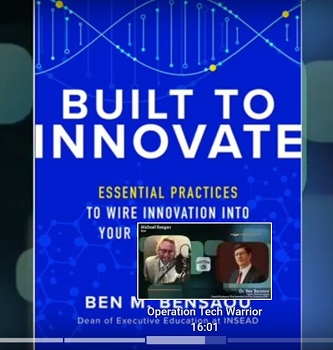
Nurturing the Habit of Innovating

Dr. Ben Bensaou, author of Built to Innovate joined me on The Business of Government Hour to discuss insights from his book and explore the strategic imperative for today’s leaders to make innovating an organizational habit.
We live in a time when change is the rule, not the exception. This means that organizations including government agencies must constantly succeed at two very different, even contradictory activities. They must be exceedingly good at executing on their government missions—be it delivering services to citizens or responding to national emergencies such as the recent pandemic. This is the challenge of execution, but these same leaders must simultaneously excel at rethinking, reimagining, and improving what they do today, finding ways to improve their current operations and processes as well as devising entirely new ones that no one has yet envisioned. This is the challenge of innovating, and it is the focus of his book. Dr. Bensaou explains how to embed and nurture innovating capabilities into any organization offering proven processes and practices across variety of industries.
Innovating vs. Innovation. In the book, the author makes a subtle yet important distinction between the words innovation and innovating. Innovation refers to the output of innovating—a product, a technology, a service, and a process. By contrast, innovating refers to a process. Bensaou defines it as systematically looking for, developing, and implementing new ideas that create value. His book is filled with relevant vignettes and detail examples of organizations from across industries including the public sector that have worked to integrate innovating into their DNA. Here are some basic features they share:
- A set of clear, simple innovating processes that organizations can use to generate valuable improvements and changes in every aspect of their work
- Principles of innovating that can help organizations produce and implement not just new product ideas but also process improvements, customer enhancements, new operational models.
- An explanation of how everyone in an organization, from frontline staff to midlevel managers to senior leaders, can and must contribute to innovating, with specific guidance for team members at all of these levels
- A detailed, concrete explanation of the role of dedicated innovation specialists—what Bensaou calls the I-Team—in jump-starting the work of innovating throughout the organization, including descriptions of how successful organizations have created, organized, and implemented such a team
- A methodology with a kit of proven processes and tools that organizations in any industry can use to generate innovative ideas that will bring new value stakeholders both inside and outside the organization
Key Processes of Innovating. The central purpose in Built to Innovate is to provide leaders with a conceptual framework that can guide them in designing and continually nurturing an organization built to innovate. Bensaou identifies three key processes that drives innovating: creation, integration, and reframing.
- Creation is the process by which the organization continuously generates new ideas—the raw materials of innovating. These new ideas can relate to practically any activity that the organization performs. For example, they can include ideas for new or improved services that customers may like; ideas for making the processes for delivering services faster, more efficient, safer, or more reliable; ideas for making it easier for employees to capture, process, and share information; or any other kind of idea with the potential to improve an organization’s operations.
- Integration is the second process in the innovating system. This is the process by which the dispersed innovating capabilities and resources within the organization are brought together into a enterprisewide innovating capability. You can think of integration as the process by which the organization “connects the dots” among all the ideas springing from the frontline employees as well as other levels of the organization. The integration process connects people, linking innovators throughout the organization into a social network fully dedicated to innovating. The connecting network may also extend beyond the boundaries of the organization, including external innovation partners such as customers, suppliers, and academic institutions. It includes a system for evaluating, selecting, supporting, and channeling the best ideas that emerge from the creation process.
- Reframing is the third process of innovating. To prepare for the future, every organization has to keep questioning its existing strategy even while implementing it. Reframing, then, is about shifting your mental gears sufficiently to recognize the potential value in an innovation. It’s also about altering your assumptions about your mission so as to make the innovation part of a new status quo—a better way of working that creates more value for you and for those your serve.
According to Bensaou, a leader’s ultimate goal should be to embed all three processes at each level of their organization. He acknowledges this takes time, but he also identifies minimal traits of an organization that is built to innovate:
- ability to inspire individual creativity and initiative in all its people.
- ability to link and leverage the distributed pockets of innovating activity and individual expertise across the organization by connecting frontline innovators into a coordinated community and an integrated process of organizational learning.
- ability to continuously question itself and challenge some of its shared assumptions about its operations and how it delivers to those it serves.
Built to innovate offers practical advice and recommendations on how to pursue and embed innovation within any organizations based on a vast array of case studies and real life experiences. The insights in this book can help government executives approach innovating from a new perspective perhaps assisting those agency leaders with projects selected as part of the Technology Modernization Fund (TMF), or agency leaders who continue to manage pandemic relief programs, and those government executives charged with ensuring the success of cross agency priority goals. If you have an important government mission under your charge, then you have an opportunity to build innovation into how you deliver and meet that mission.
Complete Interview:https://bit.ly/3C0iCGP



